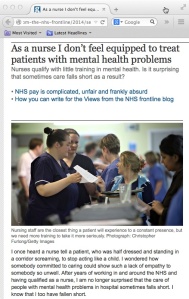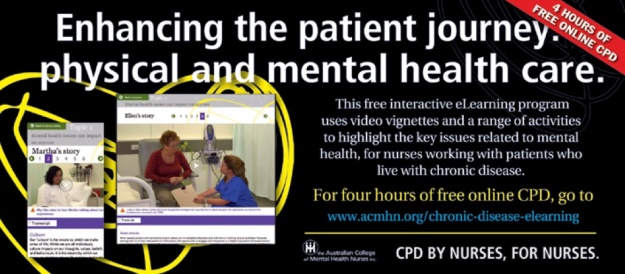This post is a companion piece to my keynote presentation at the 5th Annual Queensland Consultation Liaison Psychiatry Symposium “Modern Approaches in CL Psychiatry”, on 2nd November 2017,
The function of this page is to be a collection point to list references/links that will be mentioned in the presentation. The Prezi is intended as an oral presentation, so I do not intend to include a full description of the content here.

Click on the picture to see the Prezi
Bio/Intro (you know speakers write these themselves, right?)
Paul McNamara is a CL CNC in Cairns.
Paul has been dabbling in health care social media since 2010. He established an online portfolio in 2012 which includes Twitter, Facebook, Instagram, YouTube and a Blog.
In 2016 Paul was appointed to the Editorial Board of the International Journal of Mental Health Nursing specifically because of his interest in social media.
This morning’s presentation “Social Media & Digital Citizenship: A CL Nurse’s Perspective” aims to encourage the converts, enthuse the curious, and empower the cautious.
Disclaimer/Apology/Excuse
Regular visitors to meta4RN.com will recognise some familiar themes.
Let’s not call it self-plagiarism (such an ugly term), I would rather think of it as a new, funky remix of a favourite old song.
Due to this remixing of old content I’ve included lots of previous meta4RN.com blog posts on the reference list.
This, in turn, makes the reference list look stupidly self-referential. #TrumpBrag 
Anyway, with that embarrassing disclosure out of the way, here is the list of references and links cited in the Prezi prezi.com/user/meta4RN
References + Links
Altmetric Attention Score [example] https://wiley.altmetric.com/details/23964454
Australian College of Nursing (n.d.) Social media guidelines for nurses. Retreived from http://www.rcna.org.au/WCM/…for_nurses.pdf
Australian Health Practitioner Regulation Agency. (2014, March 17). Social media policy. Retrieved from http://www.ahpra.gov.au/News/2014-02-13-revised-guidelines-code-and-policy.aspx
Casella, E., Mills, J., & Usher, K. (2014). Social media and nursing practice: Changing the balance between the social and technical aspects of work. Collegian, 21(2), 121–126. doi:10.1016/j.colegn.2014.03.005
Facebook. (2015). Facebook logo. Retrieved from https://www.facebookbrand.com/
Ferguson, C., Inglis, S. C., Newton, P. J., Cripps, P. J. S., Macdonald, P. S., & Davidson, P. M. (2014). Social media: A tool to spread information: A case study analysis of Twitter conversation at the Cardiac Society of Australia & New Zealand 61st Annual Scientific Meeting 2013. Collegian, 21(2), 89–93. doi:10.1016/j.colegn.2014.03.002
Fox, C.S., Bonaca, M.P., Ryan, J.J., Massaro, J.M., Barry, K. & Loscalzo, J. (2015). A randomized trial of social media from Circulation. Circulation. 131(1), pp 28-33
Gallagher, R., Psaroulis, T., Ferguson, C., Neubeck, L. & Gallagher, P. 2016, ‘Social media practices on Twitter: maximising the impact of cardiac associations’, British Journal of Cardiac Nursing, vol. 11, no. 10, pp. 481-487.
Instagram. (2015). Instagram logo. Retrieved from https://help.instagram.com/304689166306603
Li, C. (2015). Charlene Li photo. Retrieved from http://www.charleneli.com/about-charlene/reviewer-resources/
lifeinthefastlane. (2013). #FOAMed logo. Retrieved from http://lifeinthefastlane.com/foam/

My Tweets = my lecture notes. Other people’s Tweets also = my lecture notes. 🙂
McNamara, P. (2017, October 16) Delirium risks and prevention. Tweets re the guest lecture by Prof Sharon Inouye at Royal Brisbane and Women’s Hospital (and Cairns via videolink) collated on Storify. Retrieved from https://storify.com/meta4RN/delirium-risks-and-prevention
McNamara, P. (2016, November 18) Twitter is a Vector (my #ACIPC16 presentation). Retrieved from https://meta4RN.com/ACIPC16
McNamara, P. (2016, October 21) Why on earth would a Mental Health Nurse bother with Twitter? (my #ACMHN2016 presentation). Retrieved from https://meta4RN.com/ACMHN2016
McNamara, P. (2016, October 15) Learn about Obesity (and Twitter) via Nurses Tweeting at a Conference. Retrieved from https://meta4RN.com/obesity
McNamara, P., & Meijome, X. M. (2015). Twitter Para Enfermeras (Spanish/Español). Retrieved 11 March 2015, from http://www.ausmed.com.au/es/twitter-para-enfermeras/
McNamara, P. (2014). A Nurse’s Guide to Twitter. Retrieved from http://www.ausmed.com.au/twitter-for-nurses/
McNamara, P. (2014, May 3) Luddites I have known. Retrieved from http://meta4RN.com/luddites
McNamara, P. (2013) Behave online as you would in real life (letter to the editor), TQN: The Queensland Nurse, June 2013, Volume 32, Number 3, Page 4.
McNamara, P. (2013, October 25) Professional use of Twitter and healthcare social media. Retrieved from http://meta4RN.com/NPD100
McNamara, P. (2013, October 23) A Twitter workshop in tweets. Retrieved from http://meta4RN.com/tweets
McNamara, P. (2013, October 1) Professional use of Twitter. Retrieved from http://meta4RN.com/poster
McNamara, P. (2013, July 21) Follow Friday and other twitterisms. Retrieved from http://meta4RN.com/FF
McNamara, P. (2013, June 29) Thinking health communication? Think mobile. Retrieved https://meta4RN.com/mobile
McNamara, P. (2013, June 7) Omnipresent and always available: A mental health nurse on Twitter. Retrieved from http://meta4RN.com/twit
McNamara, P. (2013, January 20) Social media for nurses: my ten-step, slightly ranty, version. Retrieved from http://meta4RN.com/rant1
Moorley, C., & Chinn, T. (2014). Using social media for continuous professional development. Journal of Advanced Nursing, 71(4), 713–717. doi:10.1111/jan.12504
Nickson, C. P., & Cadogan, M. D. (2014). Free Open Access Medical education (FOAM) for the emergency physician. Emergency Medicine Australasia, 26(1), 76–83. doi:10.1111/1742-6723.12191
Nursing and Midwifery Board of Australia (2010, September 9) Information sheet on social media. Retrieved from http://www.nursingmidwiferyboard.gov.au/documents/default.aspx?record=WD10%2F3224&dbid=AP&chksum=qhog9%2FUCgKdssFmA0XnBlA%3D%3D
Office of the eSafety Commisioner (2017). eSafety logo. Retrieved from https://www.esafety.gov.au
Read, J., Harper, D., Tucker, I. and Kennedy, A. (2017), Do adult mental health services identify child abuse and neglect? A systematic review. International Journal of Mental Health Nursing http://onlinelibrary.wiley.com/doi/10.1111/inm.12369/abstract
Screenshot 1 “Trump: Twitter helped me win but I’ll be ‘restrained’ now” from http://money.cnn.com/2016/11/12/media/donald-trump-twitter-60-minutes/
Screenshot 2: “Melania Trump rebukes her husband “all the time” for Twitter use” from http://www.cbsnews.com/news/donald-trump-melania-trump-60-minutes-interview-rebukes-twitter-use/
The Nurse Path (facebook) https://www.facebook.com/theNursePath
Tonia, T., Van Oyen, H., Berger, A., Schindler, C. & Künzli, N. (2016). International Journal of Public Health. 61(4), pp 513-520. doi:10.1007/s00038-016-0831-y
Twitter. (2015). Twitter logo. Retrieved from https://about.twitter.com/press/brand-assets
Wilson, R., Ranse, J., Cashin, A., & McNamara, P. (2014). Nurses and Twitter: The good, the bad, and the reluctant. Collegian, 21(2), 111–119. doi:10.1016/j.colegn.2013.09.003
https://www.sciencedirect.com/science/article/pii/S1322769613000905
Wozniak, H., Uys, P., & Mahoney, M. J. (2012). Digital communication in a networked world. In J. Higgs, R. Ajjawi, L. McAllister, F. Trede, & S. Loftus (Eds.), Communication in the health sciences (3rd ed., pp. 150–162). South Melbourne, Australia: Oxford University Press
End
Finally, a big thank you to the organisers of the 5th Annual Consultation Liaison Psychiatry Symposium, especially Stacey Deaville for suggesting this session, and Dr Paul Pun for pulling on all the right strings.

That’s it. As always your comments are welcome.
Paul McNamara, 19th October 2017
Short URL: meta4RN.com/CLPS




























